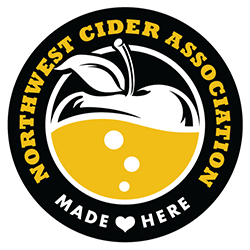This was one of the more idyllic orchards we visited. We started in their standard orchard on a gently sloping hill. It was very serene, widely spaced, tall trees with a green grass floor and birds singing all around. The top portion of the standard orchard was planted in 1999, the lower part two years later. Their operation is focused on apples and pears, no livestock or other farming ventures are a part of their cidery.
Orchard/Fruit
Their orchard contains 16 hectares of apples and 4 hectares of pears in both standard and bush systems. Their standard orchards are 120 trees per hectare while the bush orchards are at 650 trees per hectare. In their orchard they grow 30 apple varieties and eight pear varieties.

Currently all of their orchards are organic and have been since 2009 after a three year transition period. Though they started by planting their standard orchard, all of their new plantings are in bush style. They plan for harvest in 7-8 years in their bush orchards and 15-20 years in their standard orchards. When it comes to fruit quality between the two growing systems they do not see any noticeable difference. They believe that more fruit quality variation comes from the soil type rather than the rootstock or growing method.
Their most problematic disease in their orchard is apple scab. They use sulfur and copper to manage this as both are approved for organic production. All new plantings however are done with scab resistant varieties. Another method they use to mitigate scab is to mow after leaf fall to reduce the leaf matter available for the spores to overwinter on.
They typically mow their orchard five times per year. As of the end of May they have already been through two times. They prefer the grass to be 3-4” at harvest.
All of their fruit is machine harvested between September 25th and December 15-20th , including pears. They typically harvest three times. The first when the first fruit starts to drop, then eight to ten days later. During the final harvest they shake the trees to remove all the fruit.
In their orchards they average 15-20 tonnes of fruit per hectare. Some varieties will produce 35-40 tonnes per hectare one year but nothing the following. They will pick 200-250 tonnes of fruit per year from their orchards each year. Much of their orchards are young so the yield is lower than what it should be. Plant de Blanc is one of the most used varieties for perry in this region very small, round. The tree has a strange growth habit, lots of blind wood and areas of large fruit clusters.
Fruit processing
They process apples the day after they harvest, with pears they harvest in the morning and press in the afternoon. They harvest by variety, but blend at pressing. 10-12 tonnes of fruit per day is their capacity and they typically achieve a 60% yield. They use water channels to move fruit from bulk storage areas to their elevator and to the press. All fruit is hand sorted as it passes on the conveyor to the mill. They macerate for 1-2 hours, but this is just while the pomace is waiting to be loaded into the press. Sometimes they macerate the pears, but this is done in the press. If they hold the pear pomace for any time prior to pressing it will become very difficult to press the juice. Their press time is about two hours, it is a three tonne press
Fermentation
They test nitrogen levels in the juice and at bottling. They look for 20-40 ppm at bottling, 80 at bottling is too much. If the juice comes in with very low nitrogen they may not even test at bottling.
Fermentation is carried out in fiberglass tanks. Once the juice is in the tank he adds PME, then racks off when the chapeau brun forms. Optimum rate of fermentation is 2-4 SG per week. If the rate gets to 5 degrees per week they will filter to slow the fermentation with a DE filter. This will only be a partial filter, not the entire volume.

Notes
Their building was 4 years old, built into the side of the hill to facilitate temperature regulation. It was insulated but not temperature controlled. All wood from their prunings is chipped and they use the chips to heat their home. They also use wood around newly planted trees to keep the roots cool and reduce weed competition
